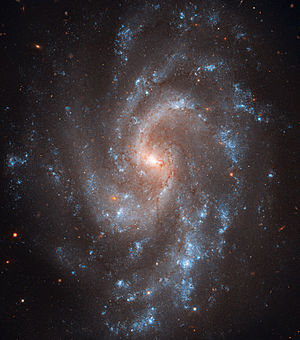NGC 5584
Appearance
| NGC 5584 | |
|---|---|
 Composite of several exposures taken in visible light between January and April 2010 with Hubble's Wide Field Camera 3. | |
| Observation data (J2000 epoch) | |
| Constellation | Virgo |
| Right ascension | 14h 22m 3.811s[1] |
| Declination | −00° -23′ 14.82″ |
| Redshift | 0.00547 |
| Other designations | |
| NGC 5584, K73 626, QDOT B1419491-000919, Z 1419.8-0009,
6dFGS gJ142223.8-002315, LEDA 51344, SDSS J142223.76-002315.6, Z 19-8, GSC 04977-00156, 2MASX J14222381-0023148, TC 541, [CHM2007] LDC 1076 J142223.81-0023148 HIPASS J1422-00, MCG+00-37-001 UGC 9201, [M98c] 141949.9-000934, IRAS 14198-0009, PSCz Q14198-0009, UZC J142223.7-002310 | |
NGC 5584 is a spiral galaxy, more than 50,000 light-years across,[2] that resides 72 million light-years away in the constellation Virgo.
The blue areas the Hubble Space Telescope image are young stars, the darker areas are dust lanes, while the reddish spots and splotches are galaxies in the background.[3]
250 Cepheid variables have been observed in NGC 5584.
The image is a composite of several exposures taken in visible light between January and April 2010 with Hubble's Wide Field Camera 3.
External links
- Spiral Key to Universe's Expansion: ESA/Hubble Picture of the week.
References
- ^ "SIMBAD Astronomical Database". Results for NGC 5584. Retrieved 2010-03-22.
- ^ Nemiroff, R.; Bonnell, J., eds. (2011-03-30). "NGC 5584: Expanding the Universe". Astronomy Picture of the Day. NASA. Retrieved 2011-04-03.
- ^ "Hubble's View of NGC 5584". Hubble Heritage Project. Retrieved 2011-04-03.
Wikimedia Commons has media related to NGC 5584.
